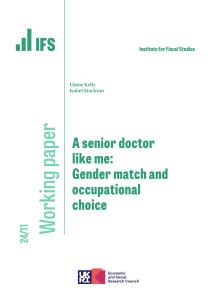Introduction
As Chapter 2 of our second annual report on the Scottish Budget showed, while the overall budget for devolved public services is currently set to be 2.2% higher in real terms in 2024–25 than initial plans for 2023–24, it is currently set to be 0.6% lower in real terms than the latest plans for the current financial year. This reflects big in-year top-ups to the budgets for justice, local government and, above all, health this year.
Of course, budgets for the coming financial year, 2024–25, can also be topped up. That does not mean that one should ignore top-ups this year when assessing what the Scottish Budget implies for different services in the coming financial year: the latest plans are the latest plans and are the best starting point for any discussion about how budgets could be revised. But it does mean that if top-ups to spending plans in 2024–25 are made, as they were in 2023–24 (and indeed many previous years), the eventual picture for public service spending will not be as difficult as current plans imply.
More funding has likely already become available for 2024–25
We may even hear about top-ups to planned spending before the Budget Bill completes its journey through the Scottish Parliament on 27 February.
First, since the Budget Bill was presented to the Scottish Parliament just before Christmas, the UK government has announced a £600 million top-up to council funding in England for 2024–25. If this is ‘new’ funding (rather than reallocated from other English budgets), this would generate just under £60 million in additional funding for the Scottish Government via the Barnett formula.
Second, the Scottish Government’s second (‘Spring’) revision to its 2023–24 Budget, published on 1 February, stated that the Scottish Government planned to draw down £310 million from ScotWind offshore windfarm licence fees in 2023–24, which is £150 million less than the £460 million assumed by the Scottish Government and the Scottish Fiscal Commission in December. This reflects higher-than-previously-assumed funding from the UK government for the current year (rather than lower planned spending) and boosts the amount of ScotWind licence fee income still available to draw down in future.
All told, these two factors would suggest around £210 million more funding may already be available for spending in 2024–25. Last February, the then Deputy First Minister John Swinney announced £223 million in additional funding for local government and teachers’ pay prior to the final vote on the 2023–24 Budget (although he did not amend the Budget Bill at that stage). It is therefore possible that we will hear about top-ups to spending plans in 2024–25 in the next few days.
Further funding will likely become available – but how much is highly uncertain
It also seems likely that further funding will become available during the course of 2024–25.
Most obviously, the UK government could top up planned spending in 2024–25. This would generate additional funding for the Scottish Government via the Barnett formula. In particular, even based on spending plans set out alongside the Autumn Statement in November, English NHS funding was set to fall 0.8% in real terms next year. And the higher-than-previously-assumed UK government funding the Scottish Government utilised in its second revised 2023–24 Budget probably reflects, at least in part, in-year top-ups to the English NHS budget since November, increasing the implied year-on-year cut next year.
Given the evident pressures on the NHS, past experience, and ambitious plans to increase staffing numbers, a top-up to the NHS England budget in 2024–25 is firmly within the realms of possibility. And if the NHS budget has been topped up this year to help pay for recurrent costs such as pay settlements, the probability of an increase next year is higher too. Each £1 billion top-up to the English NHS would generate just under £100 million for the Scottish Government via the Barnett formula. The UK government has held back around £13 billion in reserve for 2024–25, so a top-up of a few billion pounds (and hence a few hundred million for the Scottish Government) is not out of the question.
Changes in spending are not the only way the UK government’s financial decisions can affect the Scottish Government’s budget. Changes to tax policy also can – at least when they relate to taxes in the rest of the UK (rUK) that in the case of Scotland are devolved to the Scottish Government. For example, changes in income tax rates or thresholds in rUK lead to changes in funding for Scotland via changes to the block grant adjustment (BGA) associated with income tax. If income tax thresholds were raised or income tax rates were reduced, for instance, the amount of revenue raised in rUK would be lower. In turn, the BGA for income tax would be smaller too, meaning an increase in the net amount of funding available for the Scottish Government. The idea is that the Scottish Government could use this additional funding to cut income tax in a similar way north of the border too, or to spend more on devolved public services or benefits.
The Chancellor is facing pressure to cut taxes in the run-up to the next election, and a cut in income tax would be one option. The Prime Minister, Rishi Sunak, had planned a cut in the basic rate of income tax from 20% to 19% in April 2024, before the policy was canned in the aftermath of the Truss administration’s ‘mini Budget’ in Autumn 2022. Such a policy would reduce the Scottish income tax BGA by around £450–475 million. The Scottish Government would then face a choice of either matching UK policy with a 1 percentage point cut in its equivalent tax rates (the starter, basic and intermediate rates in Scotland’s soon-to-be six-band system), which would cost a similar amount, or instead using the additional funding to boost public spending, which would leave all but the very lowest income tax payers in Scotland paying more income tax than in rUK.
Increases in the income tax tax-free personal allowance would not lead to additional funding for the Scottish Government – because the UK government sets the personal allowance for the whole of the UK. Cuts to stamp duty land tax would generate additional funding, albeit likely less than cuts to income tax, given the much lower revenues involved.
Some uncertainty is inevitable, but not this much uncertainty
It therefore seems plausible that some additional funding will become available to top up Scottish Government spending plans in 2024–25, as has been the case in 2023–24. But how much and when that will become clear is highly uncertain. It is possible, and perhaps even probable, that the NHS England budget will ultimately be topped up, but the likelihood and scale of any such top-up are difficult to predict. And while it seems increasingly likely the Chancellor will cut taxes next month, how big any cuts will be and which parts of the tax system they will apply to are all very open questions.
This illustrates clearly the challenge the Scottish Government (and indeed Welsh Government and Northern Ireland Executive) faces when planning spending even for one year, let alone for the medium term.
Some degree of uncertainty is inevitable. But it need not be as significant as this.
First, the UK government could provide greater clarity about future funding. Its departmental budgets for 2024–25 have already been set, which on paper provides the Scottish Government with a figure for how much it should expect to receive via the Barnett formula. But if those budgets are to be topped up (to prevent, for instance, the NHS England budget from facing a real-terms year-on-year cut), then it would make sense to make those changes sooner rather than later. That would provide greater certainty to the Scottish Government, as well as the English services in question.
Second, as myself and two leading experts on devolved funding arrangements have previously argued, allowing the Scottish Government to borrow the equivalent of 1% or so of its funding for discretionary spending (rather than just to address tax and benefit forecast errors as currently) would meaningfully reduce in-year budgetary uncertainty, without risking the UK’s public finances. And by making borrowing repayable over just a few years, it would not pose a significant concern about fairness with respect to England (there is no English-only central government borrowing currently, although the case for this may be lower).
The Scottish Government can certainly be more transparent over the budgetary choices and trade-offs it is making. But the UK government can also make those choices and trade-offs easier to plan and make by providing greater clarity about its own spending plans, and a little extra fiscal flexibility to respond to remaining uncertainty.









